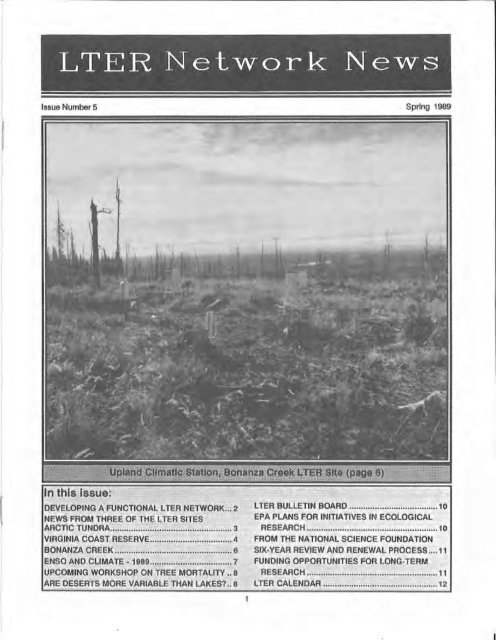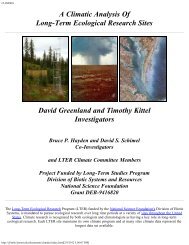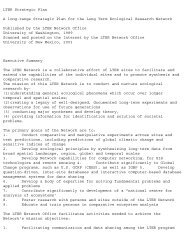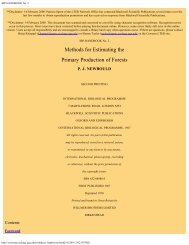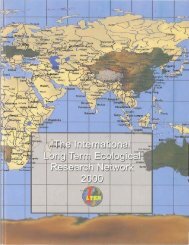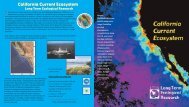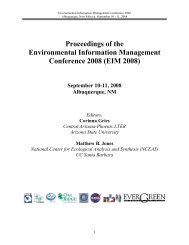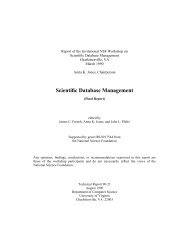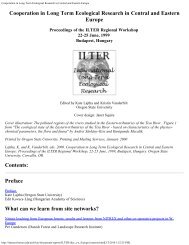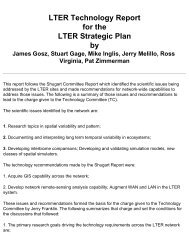1 - LTER Intranet
1 - LTER Intranet
1 - LTER Intranet
You also want an ePaper? Increase the reach of your titles
YUMPU automatically turns print PDFs into web optimized ePapers that Google loves.
Issue Number 5<br />
Spring 1989<br />
' . ::
DEVELOPING A<br />
FUNCTIONAL <strong>LTER</strong><br />
NETWORK<br />
Jerry F. Franldin<br />
While the concept of LTEA sites operating as a network<br />
has been around since the Inception of the program, it<br />
has been slow to develop. The individual <strong>LTER</strong> sites have<br />
been extremely busy getting their programs Into place-<br />
establishing experiments, Implementing data management<br />
procedures, developing functional teams, etc.<br />
There Is the scientists' Inherent suspicion of standardization<br />
In most forms and distaste for formalized administrative<br />
structures, Including coordinating<br />
commlllees, In any form.<br />
The LTEA program Is maturing, however. l TEA has a very<br />
high profile and, consequently, expectations of our peers<br />
and the National Science Foundation are also high. We<br />
are beginning to appreciate that our ability to function and<br />
produce as a network Is as critical to the long-term<br />
success and survival of the L TEA program as success of<br />
Individual site programs. More Important, we are recognizing<br />
huge potential of the L TEA network In advancing<br />
ecological science.<br />
Last November at the L TEA Coordinating Committee<br />
meeting held at the Kellogg Biological Station the Committee<br />
moved aggressively in assuming more of the<br />
responsibilities of a scientific network. Significant steps<br />
were taken which will help develop the network as an<br />
entity. These steps included: (1) a decision to develop a<br />
five-year strategic plan for the LTEA network which will<br />
also require us to Identify our collective objectives; (2)<br />
adoption of some common standards for the hardware<br />
and software necessary for communication among the<br />
LTEA sites, Including the exchange and collaborative<br />
analysis of data--the Minimum Standard Installation<br />
(MSI): and (3) establishment of a.n enlarged and central<br />
Ized network office on the University of Washington campus<br />
in Seattle.<br />
Development of a strategic plan Is the most challenging<br />
projectthatthe L TEA Coordinating Committee has undertaken.<br />
It Is Increasingly clear that we need a collective<br />
vision of how we want the <strong>LTER</strong> network to evolve. We<br />
have adopted a 5-year planning horizon. A central element<br />
of this plan will be long-term goals. Work on identification<br />
and definition of these goals began last spring<br />
and will accelerate at an April meeting in Albuquerque.<br />
New Mexico. Other elements In the plan Include identification<br />
of the organizational elements (such as lntersite<br />
modeling or data management groups, for example) and<br />
essential common measurement programs (observational<br />
and experimental) necessary to achieve the goals. The<br />
strategic plan will also need to Identify critical resource<br />
needs--such as technologies, scientific personnel, and<br />
funds.<br />
Substantial work has already begun on the Issue of technologies.<br />
A committee chaired by Dr. H.H. Shugart began<br />
the work on technology assessments In 1988 and primari-<br />
ly addressed computer and geographic information systems<br />
(GIS) needs. The MSI concept is an outgrowth of<br />
that work. A special committee chaired by Dr. James<br />
Gosz met In January to further expand our considerations<br />
of technological needs In the <strong>LTER</strong> networl< and draft the<br />
segment of the strategic plan that deals with that issue.<br />
The technologies under discussion range from the<br />
molecular to remote sensing of landscapes by satellite.<br />
We will also attempt to identify critical needs in technological<br />
development.<br />
The MSI is based on the concept that there needs to be<br />
a minimum and standardized technological capability<br />
common to all sites if the network is to communicate and<br />
be able to carry out intersite (networl
moved from Corvallis. Oregon to Seattle, Washington. We<br />
plan to have three lull-time employees at Seattle In addition<br />
to Research Coordinator Dr. Caroline Bledsoe (who<br />
Is currenlly employed by the National Science Foundation<br />
and will be spending half of her time in Seattle) and<br />
myself. The full-time staff will Include an Administrative<br />
Assistant (Stephanie Martin, who will handle a variety of<br />
tasks, Including publications), a Data Manager, and a<br />
Network Manger. The Data Manager will be devoted to<br />
facilitating data exchange between sites and development<br />
of large problem-oriented data bases. The Network<br />
Manager Is visualized as a trained scientist that will function<br />
as an executive officer for the L TEA Coordinating<br />
Commlltee, representing the network and developing<br />
details on network research, training, and planning.<br />
These steps represent significant forward progress In<br />
development of a truly functional L TEA network. I tool<<br />
forward to greatly expanded participation In planning and<br />
conducting the network activities by scientists Interested<br />
In tong-term ecological research, both Inside and outside<br />
of the formal L TEA network.<br />
Galus R. Shaver<br />
ARCTIC TUNDRA<br />
Toollk Lake Is a large, oligotrophic· kettle lake. in the<br />
northern foothills of the Brooks Range, Alaska. The tundra<br />
surrounding the lake Includes all of the common terrestrial<br />
arctic ecosystem types, as well as a number of<br />
smaller lakes, streams and rivers of various sizes. The<br />
entire region Is underlain by permafrost. with continuous<br />
daylight from mid May to late July and a snow-free season<br />
normally lasting from late May to late September. The<br />
research camp at Toollk Lake Is operated by the University<br />
of Alaska, has a current capacity of 40 scientists, and<br />
Is accessible year-round by road from either Prudhoe Bay<br />
(4 hours) or Fairbanks (9 hours). Travel along the road<br />
provides access to an even wider array of arctic ecosystem<br />
types, Including all of those common to central and<br />
northern Alaska.<br />
Long-term aquatic research at Toollk Lake began In 1975,<br />
and terrestrial ecologists began long-term experiments<br />
and observations there in 1976. Since then, about 25-30<br />
senior Investigators and many more students and·technlclans,<br />
from a number of institutions In the United States<br />
and Europe, have worked at Toolik Lake. About 10 of<br />
these scientists have maintained their research there<br />
continuously since the mid-1970's.<br />
The new arctic L TEA program at Toolik Lake is designed<br />
to build on this extensive research base, to provide core<br />
funding for ongoing, long-term experiments. and to linl<<br />
terrestrial. lake, and stream studies more explicitly than<br />
has been possible In the past. The program currently<br />
Includes 15 principal investigators from 7 different institu-<br />
3<br />
tions, including the Universities of Alaska, Cincinnati.<br />
l
over the arctic landscape, from terrestrial to aquatic<br />
ecosystems. This goal Is especially important In the context<br />
of human disturbance, because we know that the<br />
structure and productivity of terrestrial ecosystems Is<br />
strongly nutrient-limited, and that disturbance In general<br />
tends to Increase nutrient cycling rates and overall<br />
nutrient availability. We also know that aquatic ecosystems<br />
are strongly dependent on nutrient Inputs from the<br />
surrounding tundra. To describe the cycling of nutrients<br />
within different terrestrial ecosystems, and the movement<br />
of nutrients over the landscape, we are focusing on<br />
development of a model of nutrient transport, combined<br />
with the use of stable Isotopes as tracers to identify major<br />
sources, sinks, and pathways of element cycling.<br />
Evidence collected to date suggests that primary production<br />
In some sites may depend on nitrogen Inputs from<br />
adjacent ecosystems for as much as 10-20 per cent of<br />
their annual nitrogen requirement. This conclusion is<br />
based In part on the lack of correlation between annual<br />
N mineralization In soils and the annual N requirement of<br />
primary production, with surplus amounts of N mineral<br />
Ized In some sites and not enough in others. The main<br />
evidence, though, Is the series of changes In concentration<br />
of inorganic N in soil water, as the soil water moves<br />
down slope through a series of contrasting vegetation<br />
types. The sites with the greatest deficit In N mineralization<br />
are also those with the greatest decreases In lnorganlc<br />
N In soil water, suggesting that in these sites theN<br />
carried In from upslope ecosystems Is being taken up and<br />
used In support of plant production.<br />
For additional Information contact Galus Shaver, The<br />
Ecosystems Center, Marine Biological Lab, Woods Hole,<br />
MA 02543, (508)548-3705.<br />
VIRGINIA COAST RESERVE<br />
Ray Oueser<br />
The past year has been exciting for the Virginia Coast<br />
Reserve Long-Term Ecological Research Program at the<br />
University of Virginia.<br />
Thirty-three <strong>LTER</strong> subprojects were Initiated during the<br />
year, ranging from literature reviews to long-term experiments.<br />
Most of the field projects were designed to provide<br />
survey data on basic ecosystem properties (e.g .. spatial<br />
variability In soli organic matter and soli nutrient pools)<br />
for which little or no field work was devoted to designing,<br />
perfecting and Implementing sampling methods appropriate<br />
to long-term studies In a harsh environment.<br />
Plans for the forthcoming field season Include new Initiatives<br />
In stable Isotope analysis, population genetics and<br />
mlcroevolutlon, physiological ecology of evergreen<br />
shrubs, and plant demography.<br />
GIS activities progressed on several fronts. Semi-rectified<br />
versions of the 197 4 vegetation maps compiled by Cheryl<br />
McCaffrey for Hog, Rogue. Wreck. Cobb, Little Cobb, and<br />
Cedar Islands have been complied using a ERDAS GIS.<br />
The GIS Images have a resolution of 2x2 m. Final rectification<br />
to the UTM coordinate system Is expected when<br />
copies of the original aerial photographs are received In<br />
January.<br />
A geomorphological data layer was developed for Hog<br />
Island. Aerial photographs from 1985 (1 :12,000 scale)<br />
were projected onto a base map, classified based on<br />
visible geomorphological and vegetative features, and<br />
digitized using ERDAS to a 10m resolution. The resulting<br />
GIS Image has 20 classes of landscape elements ranging<br />
from active beach to low saltmarsh. A corresponding data<br />
matrix exhibits the relationship between the landscape<br />
elements and the dominant processes responsible for<br />
geomorphological change In eacrt element (e.g., storm<br />
overwash, aeolian deposition). Field work during summer<br />
1989 will test the validity of the process matrix.<br />
A botanical dataset based on Information complied by<br />
Cheryl McCaffrey has been entered Into the VCR/<strong>LTER</strong><br />
database. The dataset consists of two data files. The first<br />
contains a preliminary listing of vascular plant species<br />
known to occur on any of the VIrginia barrier Islands.<br />
along with common names. origin (Introduced. native),<br />
and growth form (shrub, tree. herb). The second file<br />
contains a listing of each island on which a species<br />
occurs, the vegetation types In which it occurs, and Its<br />
relative abundance. Both data files will expand as additional<br />
species are collected on the Islands.<br />
Above-ground primary production of marsh cordgrass<br />
(Soartlna alternlflora) Is being estimated on a series of<br />
permanent plots. The methodology, developed by Jim<br />
Morris at the North Inlet <strong>LTER</strong> site. utilizes length-weight<br />
relationships of permanently marked plants. Sediment<br />
pore-water chemistry and hydrology are being monitored<br />
at the same sites. Preliminary results suggest that both<br />
morphology and primary production of Soartlna are<br />
strongly affected by pore-water conditions, particularly<br />
4
salinity. Ultimate controls appear to include a comblnation<br />
of local climatology, terrestrial ntn-off and seasonal nJ.llQ[a decomposition was begun in March 1988. Root<br />
sea level fluctuations. Grazing by crabs on Spartina ap- decomposition and root growth into the litter bags is<br />
pears to be significant In certain sections of the coastal being studied at depths ranging from the marsh surface<br />
marshes. Emphasis will be placed during the coming year to -40 em using 50-cm long litter bags inserted vertically<br />
upon quantifying the Impact of this herbivore grazing. in the marsh sediment. Results from the first 7 months<br />
Four projects were initiated by the microbial ecology indicate different trends in the rates of weight loss begroup<br />
during the past year, Including three decomposi- tween the creek bank and the marsh interior. Decomposition<br />
studies (each concerned with a different temporal tlon rates on the marsh surface have exceeded those of<br />
scale) and a study of<br />
the buried plant material,<br />
variation in water-quality<br />
but no clear differences in<br />
along the box transect<br />
rates have been observed<br />
between the mainland between litter buried 0-<br />
and Hog Island.<br />
10 em and 30-40 em<br />
Studies of decomposl-<br />
below the surface. These<br />
tlon are usually con-<br />
results, along with measducted<br />
on time scales<br />
urements of sediment<br />
ranging from several<br />
moisture and platinum<br />
weeks to months and<br />
electrode potential, sugyears.<br />
We have initiated<br />
gest that variation In the<br />
studies with time scales<br />
rates of belowground<br />
ranging from several<br />
decomposition may be redays<br />
(short-term) to<br />
lated to differences in the<br />
months (Intermediate-<br />
degree of sediment aeraterm)<br />
to years (long-<br />
lion. We are currently testterm).<br />
In the short-term<br />
ing this hypothesis In<br />
experiments, litter dry<br />
laboratory simulations<br />
weight loss and the<br />
with controlled drainage<br />
growth and activity of<br />
regimes.<br />
microorganisms were<br />
A long-term study of the<br />
examined in detail during<br />
decomposition of Spartina<br />
the first 2 weeks of decay<br />
foliage and roots was Inand<br />
compared with later<br />
itiated on a geologically<br />
stages of decay. Litter<br />
active section of Parbagscontalningeelgrass<br />
ramore Island in June<br />
(Zo.sler rnat:ina) were 1988. This experiment<br />
submerged to the sedl-<br />
tal
Water quality monitoring at 10 permanent stations from<br />
the mainland saltmarshes to Quinby Inlet was started In<br />
July 198B. These stations are sampled monthly for bac·<br />
terlal abundance, microbial activity (respiration and incor·<br />
poratlon of acetate), dissolved organic carbon (DOC),<br />
particulate organic carbon (POC), pH, salinity, oxygen<br />
concentration, turbidity, temperature, and sediment char·<br />
acterlstlcs. Summer results show the greatest bacterial<br />
abundance and microbial activity In the mainland marsh<br />
creeks with declining abundance and activity with In·<br />
creasing distance from the mainland marshes to a mini·<br />
mum In the Inlet. Bacterial abundance and microbial<br />
activity In the back-barrier Island marsh creeks are sub·<br />
stantlally greater than at non-marsh stations but are slg·<br />
nlftcantly less than In the mainland marsh creeks. Our<br />
current hypothesis Is that the Influence of the mainland<br />
(greater nutrient input, greater sediment loads, etc.) Is<br />
responsible for higher microbial abundance and activity<br />
In the landward marshes as compared with the Island<br />
marshes. Continued monitoring will provide more lnfor·<br />
matlon regarding seasonal fluctuations In microbial<br />
processes occurring In the water column.<br />
Ecological modeling on the VCA/<strong>LTER</strong> site has been<br />
strongly oriented to developing a basis for Inter-site com·<br />
parlsons using models (Shugart 196B, Shugart and Urban<br />
1986, Shugart et al., in press) and In augmenting site·<br />
specific data collection. This orientation Is currently<br />
focused on vegetation models that simulate the lnterac·<br />
tlon of plants of differing life forms (grasses, shrubs, and<br />
trees). The philosophy behind this approach and some of<br />
the Initial results have been published In a recent<br />
workshop In Germany that discussed the use of long-term<br />
ecological research In both global and local studies<br />
(Shugart et al., In press). This work has been funded In<br />
part by the VCR/<strong>LTER</strong> Program and In part by the <strong>LTER</strong><br />
coordinating committee grant. This project Is a collaborative<br />
effort with scientists at the Central Plains and Konza<br />
Prairie L TEA sites as well as with other collaborators<br />
throughout the <strong>LTER</strong> network. BUt Lauenroth (Central<br />
Plains) Is spending his sabbatical at the University of<br />
VIrginia and has been actively Involved In this Inter-site<br />
modeling project.<br />
For additional Information contact Ray Dueser, Dept. of<br />
Environmental Sciences, University of VIrginia, Charlottsvllle,<br />
VA 22903.<br />
References:<br />
Shugart, H.H. 19B6. The Role of Ecological Models In<br />
Long-Term Ecological Studies. p. 90-109. l.n G.E.<br />
Likens (ed.), Long-Term Studies in Ecology. Springer<br />
Vet1ag, New York.<br />
Shugart, H.H. and D.L. Urban. 19BB. Scale, Synthesis,<br />
and Ecosystem Dynamics. p. 279-290. ln L. R.<br />
Pomeroy and J.J. Alberts (eds), Concepts of Ecosystem<br />
Ecology. Springer Verlag, New York.<br />
Shugart, H.H., G.B. Bonan, D.L. Urban, W.K. Lauenroth,<br />
W.J. Parton, and G.M. Hornberger. In press. Computer<br />
models and long term ecological research. ln P.G.<br />
Risser (ed.), Long-Term Ecological Research and<br />
Global Ecology. Scope Series, John Wiley, New York.<br />
6<br />
Les Viereck<br />
BONANZA CREEK<br />
Bonanza Creek Exrerlmental Forest (BCEF) was established<br />
In 1963 by the U.S. Forest Ser.tice to provide an<br />
area for basic and applied research In typical upland and<br />
flood-plain landscapes In the taiga of Interior Alaska. The<br />
area Is a part of the Tanana Valley State Forest which is<br />
leased to the Forest Service and has a long history of use<br />
by scientists from the Institute of Northern Forestry and<br />
the University of Alaska. In 1 9B3 a wildfire burned through<br />
about 2000 ha of the upland segment of the forest and<br />
has provided opportunities to study many aspects of<br />
secondary succession In a number of different ecosystem<br />
types. Forest types on the experimental forest Include<br />
white spruce, black spruce, paper birch, quaking aspen,<br />
and balsam poplar.<br />
The central hypothesis of our <strong>LTER</strong> study Is that the<br />
pattern of succession in determined primarily by Initial site<br />
characteristics and by the life history traits of component<br />
species and that the rate of successional change Is then<br />
determined by vegetation-caused changes In environ·<br />
ment and ecosystem function. We are testing this<br />
hypothesis both on the uplands, where secondary succession<br />
is Initiated by fire, and on the flood plain of the<br />
Tanana River where major flood events trigger primary<br />
succession.<br />
Since 1988 was our first full year of operation, major effort<br />
was placed on establishing permanent study plots and<br />
climate monitoring stations. We have Installed two per·<br />
manent weather stations within Bonanza Creek Ex·<br />
perimental Forest -- one on the flood plain of the Tanana<br />
River (120 m elevation) and the other on a broad ridge<br />
about midway in an elevatlonal transect In the Forest<br />
(290m elevation). Electronic data loggers are being used<br />
to monitor these sites year round. Parameters measured<br />
Include air temperature, relative humidity, soil tempera·<br />
ture, soil moisture, precipitation, evaporation, wind sped<br />
and direction, radiation, and depth of frost In the soil. All<br />
climatic data are stored In a relational menu-driven<br />
database and monthly summary reports are being<br />
produced which are available upon request.<br />
Weather data from the National Weather Ser.tlce station<br />
at Fairbanks were used to compile a long term synopsis<br />
of BCEF climate. A strongly continental climate Is lndl·<br />
cated by temperature extremes which range from ·50 to<br />
+ 35°C. The mean annual temperature of -3,3°C results in<br />
the formation of permafrost on north-facing slopes and<br />
poorly drained lowlands. July is the warmest month with<br />
mean daily temperature of 16.4"C and January Is the<br />
coldest with an average temperature of ·24°C. Annual<br />
precipitation of 269 mrn falls primarily In the summer<br />
months, while winter precipitation (about one third of the<br />
total) remains as a permanent snow cover for 6 to 7<br />
months of the year. The amount and seasonal distribution<br />
of precipitation Is almost identical to that of the Jornada<br />
<strong>LTER</strong> site In New Mexico.<br />
Our field experimental design consists of three replications<br />
of seven turning points In the two successional
sequences. Both sequences lead to white spruce and<br />
begin with a recently burned area In the uplands and<br />
young alluvial deposits on the flood plain. Three turning<br />
points were located In the uplands and four on the flood<br />
plain. We use the term turning point to emphasize the fact<br />
that In relatively short time intervals critical changes in<br />
ecosystem structure are accompanied by functional<br />
changes which have far-reaching effects on ecosystem<br />
development. Each site has a 50 x 60 m control plot<br />
designed for long term monitoring of the ecosystem. In<br />
addition. there are either three or four 30 x 40 m treatment<br />
plots depending on the experiments planned for that site.<br />
This design results In a total of 15 ha of actual plot area.<br />
There Is also sufficient area adjacent to the established<br />
plots for experimental sites which may be required In the<br />
future. During 1988 we concentrated on locating all 21<br />
experimental sites and physically marking plot boundaries<br />
on the ground. The Initial vegetation and soil Inventories<br />
have been completed In two thirds of the control<br />
plots. Seedfall and lltterfall monitoring have also been<br />
initiated. These initial Inventories will be completed during<br />
the 1 989 field season as well as stem mapping and<br />
downed tree Inventory. In addition. climatic stations have<br />
been established at one control plot In each of the seven<br />
turning points In order to monitor abiotic changes occurring<br />
wllh succession.<br />
This coming field season (1989) we will also complete the<br />
Installation of se.veral long term experiments. These include:<br />
(1) altering resource availability by adding<br />
nitrogen, sawdust, or sucrose or by limiting precipitation<br />
Input: (2) the natural pattern of colonization and succession<br />
will be altered by planting artificial communities in<br />
early succession (vegetation-free silt, N-fixlng alder.<br />
spruce. or alder + spruce): (3) moss will be removed to<br />
document the role of mosses in controlling soli temperature<br />
and nutrient cycling; and (4) herbivores will be excluded<br />
from some artificial communllles. Measurements<br />
planned for these experiments Include plant establishment<br />
and growth, soil nutrient availability, biomass<br />
and standing stocks of nutrients, soli microbial and Invertebrate<br />
activity, and secondary metabolite concentrations<br />
In plants and forest floor.<br />
The sclenllsts at Bonanza Creek Experimental Forest<br />
encourage othets who are interested to enter into<br />
cooperative research in these fascinating subarctic<br />
ecosystems. It you would like additional Information, contact<br />
Dr. Keith Van Cleve. Agricultural and Forestry Experiment<br />
Station, University of Alaska. Fairbanks. AK 99775.<br />
tions over regions as distant as the Uniled States and New<br />
Zealand are affected. One extreme of the ENSO<br />
phenomenon, associated with an increase In upperocean<br />
temperatures In the eastern equatorial Pacific, Is<br />
called an El Nino event. The opposite extreme. linked with<br />
colder than normal water In the tropical Pacific, has been<br />
called an anti-EI Nino event or, more recently, referred to<br />
as La Nina. Presently, a La Nina event with oceanic conditions<br />
stronger than any such event since the 1973-1975<br />
period exists In the tropical Pacific.<br />
Climatologists and oceanographers maintain a careful<br />
watch on the status of the ENSO phenomenon. One<br />
valuable Index for judging conditions associated with the<br />
ENSO phenomenon Is the difference In the monthly mean<br />
for sea level pressure anomalies at Tahiti and Darwin.<br />
Australia (see figure below). The monthly atmospheric<br />
Indices are standardized by the standard deviation of the<br />
appropriate long-term monthly mean at each station. The<br />
period from August to November of 1988 has had four<br />
positive values between 1 and 2. The present Index Is<br />
higher than at any time since 1975 and indicates that a<br />
strong La Nina phase is now occurring. The data used in<br />
this figure and other climate diagnostic Information are<br />
available free of charge lh the monthly Climate Diagnostic<br />
Bulletin which can be obtained through the Climate<br />
Analysis Center, W/NMC52, NOANNWS/NMC. Room<br />
605, World Weather Building, Washington. D.C. 20233.<br />
Please specify that you wish to receive the Climate Diagnostic<br />
Bulletin.<br />
An example of the relationships between the ENSO<br />
phenomenon and winter precipitation patterns In North<br />
America can be seen In spring runoff from the Gila Hiver<br />
In New Mexico. Spring discharge from the Gila River near<br />
Gila, New Mexico, a site approximately 200 km southwest<br />
of the Sevilleta L TEA and 175 l
L TEA, Is plotted for 1969-1988. Spring runoff of snowmelt<br />
from a mountainous region such as the Gila drainage<br />
basin Is a good spatial and temporal integrator of regional<br />
precipitation from the late fall until early spring. The two<br />
highest spring discharges from the Gila occurred In 1973<br />
and 1983 after the strong El Nino events of 1972-73 and<br />
1982-83. Another year with higher than average spring<br />
discharge, 1987, followed the moderate El Nino event of<br />
1986-87. La Nina events have generally been associated<br />
with reduced spring discharge from the Gila. The extended<br />
period of positive anomalies In the Southern Oscillation<br />
Index from the middle of 1970 until early 1972<br />
were reflected In very low runoff from the Gila In 1971 and<br />
1972. The two other La Nina events in this period of<br />
record, late 1973 to 1974 and mid-1975 to early 1976, also<br />
were associated with below normal discharge in 197 4 and<br />
1976. No strong La Nina events have occurred since the<br />
mid-1970's until the present conditions which began In<br />
the second half of 1988. At the present time, the Southwestern<br />
U.S. Is experiencing a dry winter.<br />
The ENSO phenomenon has a global Impact on climate.<br />
ENSO-affected regions are known to typically have<br />
greater variability In annual precipitation than regions<br />
without direct teleconnectlon to ENSO. In more northerly<br />
altitudes of the U.S., the Influence of ENSO phenomena<br />
on precipitation may be the opposite of that documented<br />
for the Southwest. For example, the Northwest may experience<br />
Increased winter precipitation during a La Nina<br />
phase. It will be of Interest to see If, and how, the various<br />
<strong>LTER</strong> sites are affected by this important perturber of<br />
global weather during this current La Nina winter.<br />
Additional Information may be obtained by contacting<br />
one of the authors at the Dept. of Biology, University of<br />
New Mexico, Albuquerque, NM 87131.<br />
UPCOMING WORKSHOP<br />
ON TREE MORTALITY<br />
Tree mortality Is an excellent, but long neglected, subject<br />
for long-term study. Moreover, tree mortality Is fundamental<br />
to understanding how forested ecosystems function<br />
and respond to stress. Despite conventional wisdom that<br />
perennial plant demography can not be studied, experience<br />
from the Andrews l TEA suggests even a 10 year<br />
study provides considerable Insight Into the demography<br />
of long-lived tree species. Tree mortality Is also neglected<br />
from short-term lltterfall and production studies, the end<br />
result being that this process has been virtually ignored<br />
In global carbon budgets. Data from the Andrews l TEA<br />
Indicates tree death accounts for 50% of the above<br />
ground litterfall and for ca. 30% of the above ground net<br />
primary production In old-growth conifer forests.<br />
This paucity of Information need not continue! <strong>LTER</strong><br />
could provide a valuable service to all by Identifying<br />
available data sets, focusing future research efforts, and<br />
synthesizing existing information. In order to foster Intersite<br />
comparisons and synthesis, Mark Harmon and Jerry<br />
Franklin will be hosting a three day workshop on tree<br />
mortality In Corvallis In September 1989. Tentative discus-<br />
8<br />
sion topics Include: (1) possible comparative studies/syntheses<br />
within L TEA; (2) Identifying existing data sets<br />
within and outside L TEA: (3) examine data requirements<br />
for meaningful regional and global syntheses: (4) standardization<br />
of methods: and (5) the relevance of this<br />
process toward understanding ecosystem succession,<br />
modeling, nutrient cycling, and production.<br />
Limited funding will be available for travel of the participants,<br />
so if someone at your site (Including nonLTEA<br />
sites) would like to participate In the workshop please<br />
contact: Dr. Mark E Harmon, Department of Forest<br />
Science, Oregon State University, Peavy Hall 154, Corvallis,<br />
OR 97331-5705<br />
ARE DESERTS MORE<br />
VARIABLE THAN LAKES?<br />
John J. Magnuson, Timothy Kratz, and Gary Cunningham<br />
We often think of a desert as being an exposed ecosystem<br />
with a highly variable, severe environment where variation<br />
In precipitation Is critical. In contrast, we view a lake as a<br />
more constant environment well buffered from thermal<br />
change by the mass and heat capacity of water and from<br />
biological Invasions owing to Isolation. How can such<br />
qualitative presumptions be tested quantitatively?<br />
Comparison of different ecosystems In a non-trivial<br />
fashion Is often difficult because there are few common<br />
entities. Deserts and lakes provide a classic example of<br />
this. It Is difficult to compare fish and small mammals,<br />
zooplankton and ants, forbs, and phytoplankton. The<br />
more Imaginative can think of analogous metrics in structure<br />
of food web assemblages and processes such as<br />
energy flow and biogeochemical cycling. Yet, we do not<br />
have a means of quantitatively comparing the temporal<br />
and spatial variability of desert and lake ecosystems.<br />
An lntersite activity Is In full swing to explore new metrlcs<br />
for comparing similarities and differences in the temporal<br />
and spatial variability of diverse ecosystems. Variability is<br />
common to all ecological systems and is a feature which<br />
is thought to be Important by ecologists. Although<br />
ecosystem variability Is not well understood. we expect<br />
that a serious analysis of It can provide Insight Into forces<br />
affecting ecosystem processes as well as a meaningful<br />
measure with which to compare different ecological systems.<br />
Here we provide some preliminary results compar<br />
Ing the variability of two ecosystem types: a southwestern<br />
U.S. desert (the Jornada Desert l TEA Site In New Mexico)<br />
and northern temperate lakes (the North Temperate<br />
Lakes LTEA Site In Wisconsin).<br />
To formalize the analysis, we computed variability estimates<br />
from a standard two-way analysis of variance<br />
where location In the ecosystem (different geomorphic<br />
units at Jornada; different lal
parameter: variation among locations, variation among<br />
years, and variation owing to the combination of measurement<br />
error and Interaction between year and location<br />
which we called variation owing to "other". Data were<br />
relativlzed by dividing each value In a location by year<br />
matrix by the grand mean of the matrix. This transformation<br />
was done to dampen the effects of measuring different<br />
parameters in different units. We also calculated<br />
the proportion of variance explained by location, year,<br />
and other from a model II ANOVA.<br />
As most realists might have expected, the answer to<br />
whether deserts are more variable than lakes Is "it<br />
depends on the measure of variability and on whether we<br />
consider climatic, edaphlc, plant, or animal data" (see<br />
figure). However, there are some generalities that<br />
emerge In our first statistical analyses using nonparametric<br />
paired comparisons.<br />
groundwater flow system are more Influential than the<br />
position along the catena in the desert, at least for abiotic<br />
variables.<br />
Among "other", deserts tend to be more variable than<br />
lakes for abiotic variables while lakes tend to be more<br />
variable for animals (see figure). The striking feature Is that<br />
variation owing to other (Interaction and error) Is much<br />
greater for animals in lakes than deserts. We think that the<br />
interaction term dominates for animals In lakes because<br />
most of the fish In our samples are young of the year and<br />
the recruitment of young fishes is notoriously variable<br />
among years, but different lakes respond differently in a<br />
given year. For example In one lake one species of fish<br />
(yellow perch) is dominant while in another lake a different<br />
species (bluegill) is -- conditions favoring one species<br />
may not favor the second species. Also, the smaller lakes<br />
are better buffered from damaging effects of storms on<br />
Are Lakes or Deserts More Variable?<br />
Jarnada Versus North Temperate Lakes<br />
..<br />
0<br />
..<br />
"<br />
a:<br />
,.<br />
.. ,.<br />
"-'<br />
w<br />
"'<br />
~ '<br />
;::: '<br />
Y£4R<br />
a., ~~~j I<br />
.~~:-~i~<br />
CUW.OC :::lA.PH~ ~IJ,NT ANIM,.I,~<br />
LOCATI0/'1<br />
OTHER<br />
,......... o.. ... 1:1<br />
0..... .... ... .. .......,:i'''''"'"'''''"''<br />
CliirAA'I'.e ·~·---==--~-~<br />
E.CAPMC Pl,.A/o'1 ,um.l,AI,<br />
c<br />
..<br />
1: o .•<br />
c<br />
"' g O.J.<br />
...<br />
Among years, deserts are more variable than lakes (see<br />
figure). Relative variances among years for deserts are<br />
greater than for lakes for climatic and plant data. Also, the<br />
proportion (r2) of the total variance due to years is greater<br />
for deserts than for lakes for climatic, plant, and animal<br />
data. Apparently deserts are less buffered from year to<br />
year variability In weather than lakes and this is evident<br />
not only In the climatic measures but also in the plant and<br />
animal data.<br />
Among locations, lakes tend to be more variable than<br />
deserts (see figure). The proportion (r2) of the total<br />
variance Is greater for lakes than for deserts in climatic<br />
and edaphic characteristics, but greater for deserts for<br />
animal characteristics. Apparently the greater physical<br />
Isolation among lakes and the influence of position in the<br />
fish eggs and larvae compared to the large lakes. Thus<br />
the interaction between year and lake effects could well<br />
be reaL The greater importance of Interaction In the<br />
abiotic characteristic of deserts over lakes is less clear.<br />
Perhaps differences In water retention characteristics<br />
among the desert locations cause the different geomorphic<br />
units to respond differently to rain events.<br />
The above analysis and preliminary interpretation appear<br />
to provide a means of making meaningful comparison<br />
between divergent ecosystems such as lakes and desert.<br />
They also cause one to search the back of their mind for<br />
processes which might generate the difference in observed<br />
patterns of yearly and spatial variation. Some of<br />
these confirm our expectations, others we believe will<br />
catalyze new research.<br />
9
<strong>LTER</strong> BULLETIN BOARD<br />
Bill Lauenroth<br />
The L TEA network bulletin board is up and running at<br />
Colorado State University. It is running on a Sun 3861<br />
named Goecoccyx and can be accessed via tel net or over<br />
a phone line with a modem. The telnet address of<br />
Geococcyx Is 129.82.104.22 and the telephone number<br />
Is 303-491-5603.<br />
When you connect you will see a prompt for a login name.<br />
The login name Is Iter (be sure to use lower case for all<br />
responses). This will get you directly into the bulletin<br />
board program. The first time you log onto the bulletin<br />
board you will have to provide identification Information.<br />
In subsequent sessions you will only have to provide your<br />
name and password.<br />
The bulletin board Is organized Into conferences and<br />
subconferences. It Is very easy to add conferences In<br />
response to topics of Interest to L TEA scientists. Please<br />
feel free to make suggestions about conferences In which<br />
you would like to pantclpate. There Is a suggestions<br />
sub-conference under the general conference.<br />
If you have any questions or problems In accessing the<br />
bulletin board please contact the system operator Manln<br />
Fowler (martln@cusgnat.nrel.colostate.edu, 303-491-<br />
1996). Tom Kirchner (tomnrel@csugold, 303-491-1986),<br />
or Bill Lauenroth (wkl3a@vlrglnla, 004-924-0552).<br />
EPA Plans for Initiatives in<br />
Ecological Research<br />
LEAN quickly recognized that a strategic ecological effects<br />
research program must accommodate a spectrum<br />
of decisions, both in the present and in the future, concerning<br />
environmental quality. Moreover, such a program<br />
must take into account that EPA Is a rlsl< management<br />
agency and that, to meet its responsibility, ecological<br />
research programs must be planned and carried out In<br />
the context of an ecological risk assessment paradigm.<br />
At least three major developments in the area of environmental<br />
protection have led to the need for this risk<br />
paradigm. The first Is the realization that the aggregate<br />
effect of apparently rational decisions about single chemicals.<br />
releases, or stresses may place a total multlpollutant<br />
stress on ecosystems. The second Is the realization that<br />
indirect and cumulative effects lrom pollutants are a<br />
threat to ecological resources and can only be anticipated<br />
by having a full understanding of the Interactions<br />
between pollutants and ecosystems. Finally, some of the<br />
most important stresses to be dealt with now are so<br />
pervasive that their full impact can only be understood at<br />
the ecosystem level.<br />
The RSC committee recommended a core program of<br />
ecological effects research that would be built around<br />
four strategic elements: (1) defining the status ol ecological<br />
systems; (2) detecting trends and changes in ecosystems;<br />
(3) predicting changes In ecosystems; and<br />
(4) assessing risks to ecosystems. These elements are<br />
more fully described In the LEAN committee report entitled<br />
"Strategies for Ecological Effects Research", copies<br />
of which can be obtained from the Science Advisory<br />
Board. In addition to recommending a broad and ex-<br />
Stan Auerbach<br />
In 1987 EPA administrator Lee Thomas requested that the<br />
EPA Science Advisory Board (SA8) establish a committee<br />
to review the agency's past and present programs In<br />
ecological research and to outline a program of long-term<br />
ecological research related to the agency's needs.<br />
Thomas' concerns were threefold: (1) over the past<br />
decade the- EPA research program had evolved Into a<br />
program focusing on shon-term needs, to the detriment<br />
of meeting long-term research responsibilities; (2) EPA's<br />
research and development program has to be expanded<br />
and reoriented to Include much more basic. long-term<br />
research not necessarily tied to the Immediate regulatory<br />
needs of EPA's program offices; and (3) the agency must<br />
be able to anticipate and prlorltl:ze future threats to<br />
ecological resources In order to suppon research and<br />
programs dealing with such threats.<br />
Early In 1980 the committee (named the long-Term<br />
Ecological Research Needs Committee [LEAN)) became<br />
a part of a new SAB special committee on research<br />
strategies (RSC). LEAN was charged witll assessing<br />
EPA's long-term research needs and developing the<br />
strategic elements of a research program that would<br />
enable the agency to meet those needs and fulfill its<br />
mission--a mission that Is broader than simply that of a<br />
regulatory agency.<br />
10
panded program of research, the RSC recommended<br />
that EPA establish and fund a new environmental institute<br />
that would play a key role In an enlarged, coordinated<br />
program of national ecological research. This Institute<br />
would have several functions: (1) It would conduct a core<br />
ecological research program that would Interact with<br />
other major ecological research programs, such as the<br />
NSF-<strong>LTER</strong>, DOE-NEAP, and MAS-Biosphere Reserve efforts<br />
as well as those of other federal agencies. (2) It<br />
would have a central responsibility In the design and<br />
Implementation of a national ecological monitoring program,<br />
which Is needed to provide an overall picture of<br />
ecological health. (3) It would serve as a center for data<br />
analysis and synthesis with the charge of analyzing and<br />
defining trends In ecological quality and describing those<br />
trends In an annual report to the nation on overall quality<br />
of the environment.<br />
During the past quarter century, U.S. ecologists have had<br />
a number of major opportunities to which they have<br />
responded with vigor and enthusiasm. These Include the<br />
radioecology research programs of the Atomic Energy<br />
Commission which provided much of the experimental<br />
and theoretical systems analysts bases for ecosystem<br />
ecology; the Blome Programs of the U.S. IBP which<br />
established ecosystem ecology as a viable area of research;<br />
and the followup ecosystem program represented<br />
by the NSF <strong>LTER</strong> effort. The new Initiatives of the<br />
EPA not only reflect this past effort but If supported and<br />
Implemented would result In the greatest quantum jump<br />
In long-term ecological research In our short history.<br />
Author's address: Environmental Sciences Division, Oak<br />
Ridge National Laboratory, Oak Ridge, TN 37831-6036.<br />
Six ... vear Review and<br />
Renewal Process<br />
Tom Callahan, National Science Foundation and<br />
Caroline Bledsoe, Research Coordinator, L TEA Network<br />
OHice<br />
NSF has outlined a 6-year plan for review and renewal of<br />
the L TEA projects. Projects will be grouped Into 3 cohorts<br />
and receive 6 year grants. For each cohort, In the renewal<br />
year, renewal proposals will be due February 1. Panels<br />
will meet In April of that year to review the proposals, and<br />
renewal funding set for October 15 of that year. All<br />
projects will have regularly scheduled site reviews midway<br />
through the six year cycle (during odd-numbered<br />
years). All projects will submit a progress report during<br />
June of each year.<br />
Proposal and funding dates are February 1 and October<br />
151n 1990 (Cohort 1--Andrews, Central Plains, Coweeta,<br />
Konza, North Inlet, Niwot Ridge, and North Temperate<br />
Lakes), 1992 (Cohort 2--Bonanza Creek, Hubbard Brook,<br />
Kellogg, Arctic Lakes, and VIrginia Coast Reserve), and<br />
1994 (Cohort 3--Cedar Creek, Jornada, Harvard Forest,<br />
Luquillo Puerto Rico. and Sevllleta).<br />
FUNDING OPPORTUNITIES<br />
FOR LONG-TERM<br />
RESEARCH<br />
John J. Magnuson<br />
The National Science Foundation has developed several<br />
opportunities that can be used to enrich the research<br />
activities at L TEA sites. The first cycle for most of these<br />
has passed but these opportunities should be kept In<br />
mind for later this year.<br />
(1) 1989 INTERNATIONAL TRAVEL GRANTS FOR<br />
GRADUATE STUDENTS. 200 travel awards are available<br />
to enable outstanding graduate students nearing completion<br />
of their doctoral studies (or those receiving a Ph.D.<br />
after 1985) to attend two-week NATO Advanced Study<br />
Institutes In Europe. The announcements of Individual<br />
Institutes are In the final January 1989lssue of Science or<br />
are available from NSF (202-357-7536).<br />
(2) FELLOWSHIP OPPORTUNITIES IN ENVIRONMEN<br />
TAL BIOLOGY FOR NEW Ph.D's. The deadline for 1990<br />
should be about August 1, 1989. There were 20 awards<br />
for 1989. One of the objectives of this program Is to<br />
"encourage the young scientist to move to a new Institution<br />
and research environment In order to benefit from<br />
new experiences and exposure to new concepts".lt might<br />
be an ideal mechanism to encourage new Ph.D.'s<br />
(American nationals) to get involved In <strong>LTER</strong> landscape<br />
ecology using geographic Information systems, for example.<br />
Inquires In writing go to Postdoctoral (EB) Fellowships,<br />
Rm 215, Biotic Systems and Resources, NSF, 1800<br />
G Street, NW, Washington, D.C. 20550.<br />
(3) MID-CAREER FELLOWSHIP OPPORTUNITIES IN EN<br />
VIRONMENTAL BIOLOGY. The deadline for 1990 should<br />
be about 1 December 1989. A maximum of 10 awards<br />
were to be made for 1989. The program encourages<br />
experienced scientists to move temporarily to a new<br />
Institution and research environment or learn new research<br />
methods, techniques, or concepts. It also<br />
promotes scientific collaborations, both domestic and<br />
International, Including Interdisciplinary ventures. It could<br />
provide experienced <strong>LTER</strong> Investigators an opportunity<br />
to conduct significant lnterslte research at another L TEA<br />
site. Inquires go to BSR Mid-Career Fellowships, Rm 215,<br />
Biotic Systems and Resources, NSF.<br />
(4) PROGRAM FOR LONG AND MEDIUM-TERM RE<br />
SEARCH AT FOREIGN CENTERS OF EXCELLENCE. The<br />
deadline for 1990 should be about 1 January 1990, and<br />
the opportunity Is limited to American nationals who<br />
earned a PhD within six years before the visit starts. The<br />
purpose is to encourage collaborative research relationships<br />
with foreign countries and to facilitate access to<br />
foreign centers and scientists through research visits<br />
from 3 to 15 months. Inquires go to the Division of<br />
International Programs, NSF.<br />
11
(5) SUPPLEMENTS FOR RESEARCH AT LONG-TERM<br />
ECOLOGICAL RESEARCH SITES. The deadline for 1990<br />
should be about 15 November 1989. The opportunity has<br />
been limited to scientists with an active NSF grant In<br />
Ecology, Population Biology and Physiological Ecology,<br />
or Ecosystems to work at an L TEA site at another Institution.<br />
On the one hand, this Is an excellent means for an<br />
NSF funded scientist to take advantage of the benefits of<br />
working at an <strong>LTER</strong> site. and on the other hand for <strong>LTER</strong><br />
sites to attract new science and scientists to their site.<br />
Last year the response was good with one to three<br />
applications being submitted for work at each L TER site.<br />
It Is not too soon to start developing contacts for the 1990<br />
call for addenda. Inquires should be directed to Dr.<br />
Thomas Callahan, NSF, (202-357-9596) or to the individual<br />
L TEA site or sites of Interest.<br />
Note:<br />
Nancy Munn (Ph.D. student under Judy Meyer's direction<br />
at the University of Georgia) received the first E. Lucy<br />
Brown award for the best student poster presented at the<br />
1988 ESA meeting. Congratulations Nancyl<br />
If you would like 19 be placed on the mailing list or If<br />
you have · cr;>tnmen~s oon~ernlng _the newsletter,<br />
dltect yo:Utreqliests1o: Stephanie Martlh. College of<br />
Forestry Re.sqlir .c~s<br />
AR · 1 Oi Uhlverslty ,of<br />
Washingtqtli: ~~a.HI.e.; WA ~6.1.95, . ·<br />
. ·.::_./::j:~::: .. r~ ::~;: ~:~?:~~;1;~~;:~··-\::::~. .·. ~ •'• .. u~w-·. -~·-·-· ~ ~-~9 :<br />
Editorial Sti:dt(


